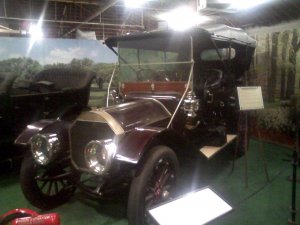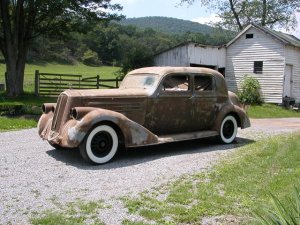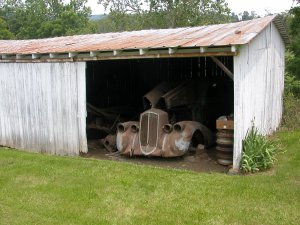- Home
- About Us
- Join/Renew
- Member Benefits
- Member Pages
- Log In
- Help
- Museum Store
Hi- since we’re doing memorabilia too, here are a few interesting Pierce pieces (well, one’s not Pierce, but it’s Buffalo!), some rare some not.
–1911 Ten Years of Industrial Activity medal (a real one)
–badge – “Automobile club of [picture of buffalo in middle]”
–two bird feeders to fit on bird cage (one water, one food), marked “Pierce Buffalo NY May 1878”
–Pierce bicycle medal with ribbon
–Pierce “July 1920 Truck Convention” medal with ribbon
–Endurance test medal, New York to Pittsburgh, October 7 to 15 1903, National Ass’n of Automobile Mfg’rs, awarded to George N. Pierce Co., appears gold plated
Ed, you’re a wealth of information about Pierce cars…
I thought I knew that there were 4 Model 43 Phaetons, mine, Phil’s that was sold recently, Mr. Dluhy of course with the best one, and then another in Texas. All of a sudden, one shows up overseas. Ya never know, there are still “unknown” (more or less) Pierce cars out there…I always get a kick out of someone saying “one of X known.” There are cars out there, it’s a big country and world…..
Here’s a very nice early Pierce….once owned by Harrah…now sitting in a museum….sorry for poor quality of picture…although it does have a certain artistic value…like a dream……

Sheesh. Wish I’d seen that sight, the convertible coupe staring at me…..ya had good luck on that one…best dc
…..and as it looked when I drove it to the Pierce Arrow tent at Hershey a couple years ago, best comment from a young lady ….”It doesn’t look like it should run…”””

Here’s the first look I had at a 1936 Pierce club sedan, driven into a shed in 1953….

Here’s one of a bunch of pictures in a safety demonstration book that I have, photos taken in New York City…..
Hi- I put inserts in my ’31 Pierce engine, lost track of time, 6 or more years ago. At the time there was a place in California (not Egge) that did them for $125 per rod, which I thought was reasonable. I believe it’s the right thing to do, particularly when modern drivers tend to go a little faster on the highway……
Yes, when looking at watches or pocket watches for Pierce, it’s tough, as there are so many reproductions. The same caveat goes for pocket watch fobs, as there were repops of those also. If it doesn’t quite look original, it’s probably not. Even those that look right might be suspect. I’ve always regreted selling the one PA fob that I found, complete with silk ribbon, and it was correct and never used..oh well, we all have those regrets…best David C.
Yikes. Well, at least the 12 engine is included. The boat tail is not an awful idea, but the execution on this one is awful. The BT loses the scale of the car as it goes back, it’s too small for the front of the car. That’s why it’s ugly, in my opinion. Properly done, with the BT well into the fenders on each side of the rear, it probably would be somewhat attractive. Bet they want big bucks for it thought….makes you wonder what shape or style the body was to start, before restoration, as it would be hard to conceive that someone would do this to a good convertible….dc
Tony- I’ll take a set, check in the mail today thanks David Coco
Well said, Ed. I can recall Irvin Blonder helping me (as he did many others) many times when I was restoring a couple of mid-30’s cars. I specifically remember the hood pieces for a 1935, he reproduced them in brass, chrome plated, and they were priced to me cheaper than I could have had the old ones just plated. I was also lucky enough to purchase a manifold for my ’31, back when they were in the $500 range, before I needed it. To your point, the time I needed it came, and I was fortunate to have it in the pile of parts. Things are much more expensive these days, and of course some of the parts are being made by people making a living in the hobby, so more expensive still.
I recently needed some muffler ends reproduced for a 1910 Hupmobile. Got a quote from one shop, $300 each end. Found a great little foundry in Boston, Mystic, and they did them for about $40 each, I’d recommend them for brass and bronze casting if anyone needs that. As Ed says, both the parts and the willingness to make replacement parts are disappearing. best to all, David C.
I thought it was, I thanked you then and thanks again! Couldn’t figure out why car was losing coolant. Wonder how many foam or overheat issues are related to not having your “magic tub!”” Best dc”
My experience with foaming was baffling. Then, I discovered that the way that antifreeze foams is by having air infused into it, and the only place that can happen is the water pump. I had it happen on a ’34 with the shaft on the pump, and ended up machining a new shaft and installing new seals instead of packing, two modern seals, facing in opposite directions. The second time was due to lack of lubricant in the water pump, and air was being pulled in through the grease fitting. Think this happened in Asheville, and it may have been Bill who had a tub of the correct grease, installed, problem gone.
Thanks Ed, who sent some history info on this car to the guy who is working on it. Always amazes me, mention a car and there’s a group of Pierce guys that know all about it….thanks David Coco Winchester Va.
Wow Terry, great transformation and wonderful looking car…you are to be commended from bringing one back from the dead, so to speak……
I can understand the crank whipping around on some early cars, my 4 cylinder 1910 Hudson has two mains, that’s scary. On a 9 main 8 cylinder, it’s hard to envision much whipping, althought it’s a good point. The mains on my ’31 Pierce are babbit, by the way, of course being mains and being 9 of them, I haven’t seen any issues. I agree too with Tony’s comment on quality of babitt material these days….best to all David C.
Hi- one of the problems with babbit and old cars is, when the crankshaft is ground to smooth, the babbit gets thicker to make up the difference. Babbit, while a great bearing surface, is a very poor heat conductor. Thus, thicker babbit means more heat retained, shorter bearing life, premature failure.
There’s a place in California (and I’m sure others could do it) that builds up the side of rods, and fits a modern bearing insert into the rod. The purists may be aghast, but it makes for a more reliable engine when rebuilding.
I like keeping things original, but some things can be re-engineered with not affecting the original “feel”” of the car.”
Tony, your last paragraph is well said and I agree totally.
I don’t have anything against hot rods, except when it involves a rare car, and any Pierce is rare when compared to a lot of makes of cars.
My ’31 Pierce phaeton was driven over 50,000 miles, in the 60’s and 70’s, by the then-owner from New Orleans. He toured the South extensively. It was never on a trailer while he owned it. I’ve not driven it to that extent, but have taken it on many tours, it can be driven anywhere, and it’s very reliable.
best- David Coco Winchester Va.
The answer is, sure it’ll work. Then what you’ll have is a cobbled up semi-hot rod that won’t be welcome at antique car events, and the hot rodders won’t like either. It shouldn’t cost that much to do an eight engine, unless it has something major broken in it. Talk to people in the hobby and find out who does what work at reasonable rates, and keep the car original if you can. Good luck. David Coco – Winchester Va.
